Background:
I’ve come across advice to avoid using a Diverter Valve (DV) spacer because apparently it is common for it to cause issues with how the car operates.

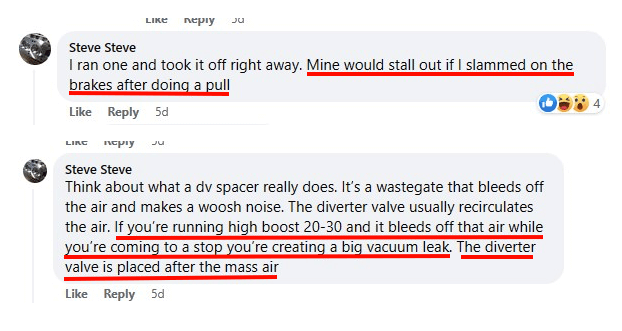
Reference to “after the mass air” flow sensor is a red flag since the Mk7 GTI does not use a Mass Airflow Sensor.

Again there’s mention of “metered air being blown off” which is a reference to the non-existent Mass Airflow Sensor.
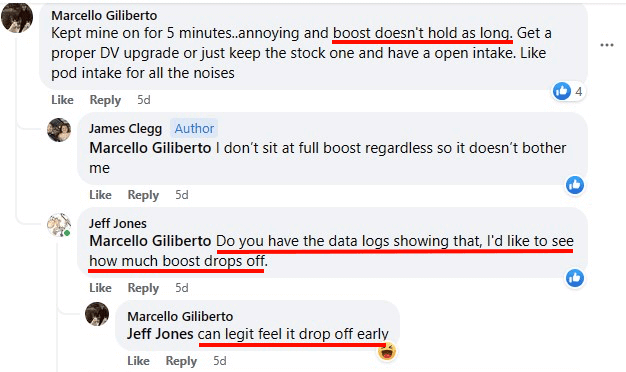
Investigation:
With all of the problems that the DV spacer causes I was anxious to get one and try it out.
Once I’d obtained an ECS Tuning DV spacer I looked it over and wondered what it was about the design that made it such a problem part.
It appears to be a simple part, it’s a piece of metal with a couple of o-ring seals and a means for securing it to the turbocharger.
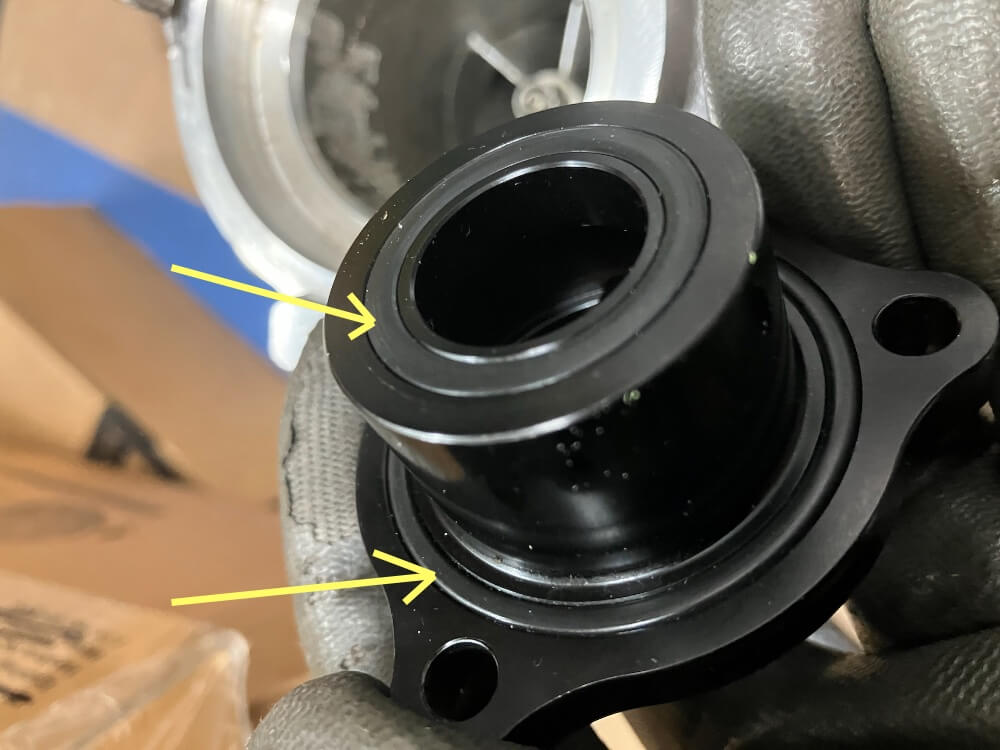
Flat surfaces of the DV spacer are flush with flat surfaces on the compressor housing, and there are those o-rings to help keep the air inside the turbo if the bolted-together flat metal surfaces don’t.
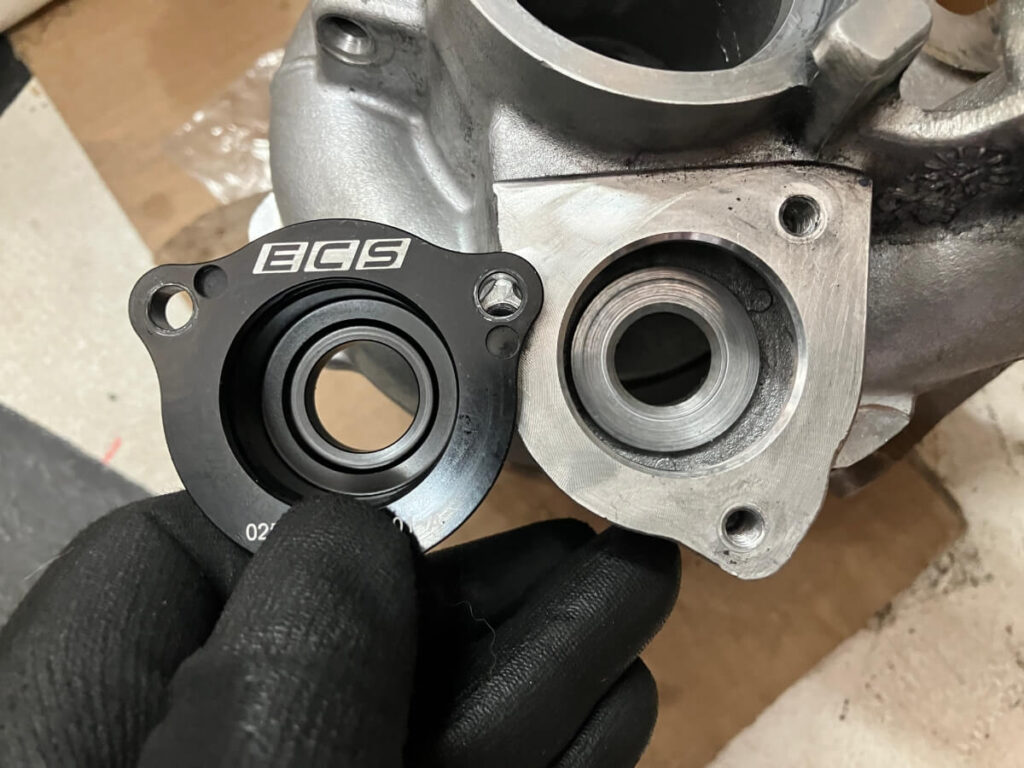
Sitting in the compressor housing the spacer looks similar to the compressor housing, with the addition of a small well for the Diverter Valve piston to sit within, something that isn’t present in the compressor housing.

The DV piston sets within the well of the DV spacer.

From appearances the DV piston sitting in the DV spacer appears to have a good seal.

At least as good as when the DV piston sits on the turbocharger housing where there is just a flat surface for it to seal with and not the small well.
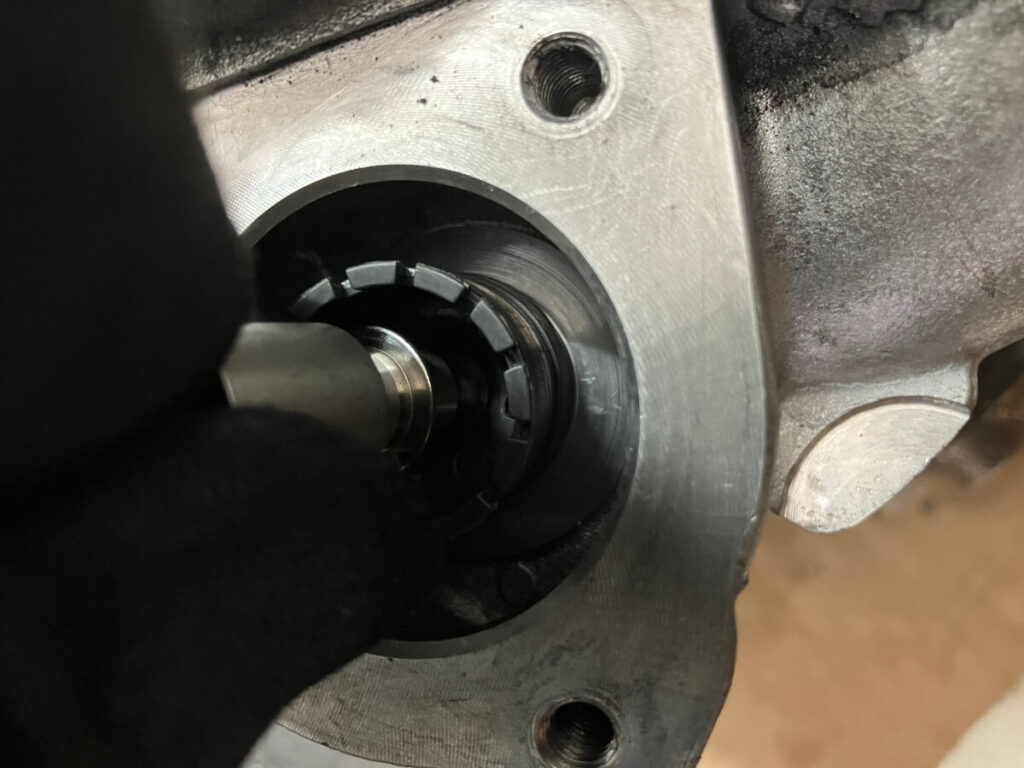
By appearances, I couldn’t find any flaw with the DV spacer design that would “introduce a boost leak for free” as the one enthusiast stated it would do.
Nobody I’ve seen discussing the issues has presented evidence to support their opinion, so next I was on to recording my own data with my GTI using the DV spacer.
Data Collection:
Unlike the other owner above whose acquaintances saw a 6 mpg drop in fuel mileage (~23% drop at a 26 mpg average), I didn’t observe a sharp drop in fuel economy while using it.
With boost leaks the most often cited issue caused by the spacer I made a point to record some full boost data and look for signs of boost pressure leaking. I did this by comparing it with a boost pressure curve made while using the stock diverter valve.

From this data, there is no indication that the spacer is causing a boost pressure leak.
Another comparison of boost pressure is made, this time the pressure at the compressor outlet is also shown along with the boost pressure at the manifold. This comparison is made using the DV spacer and another configuration using the GFB DV+ which works with the stock DV.
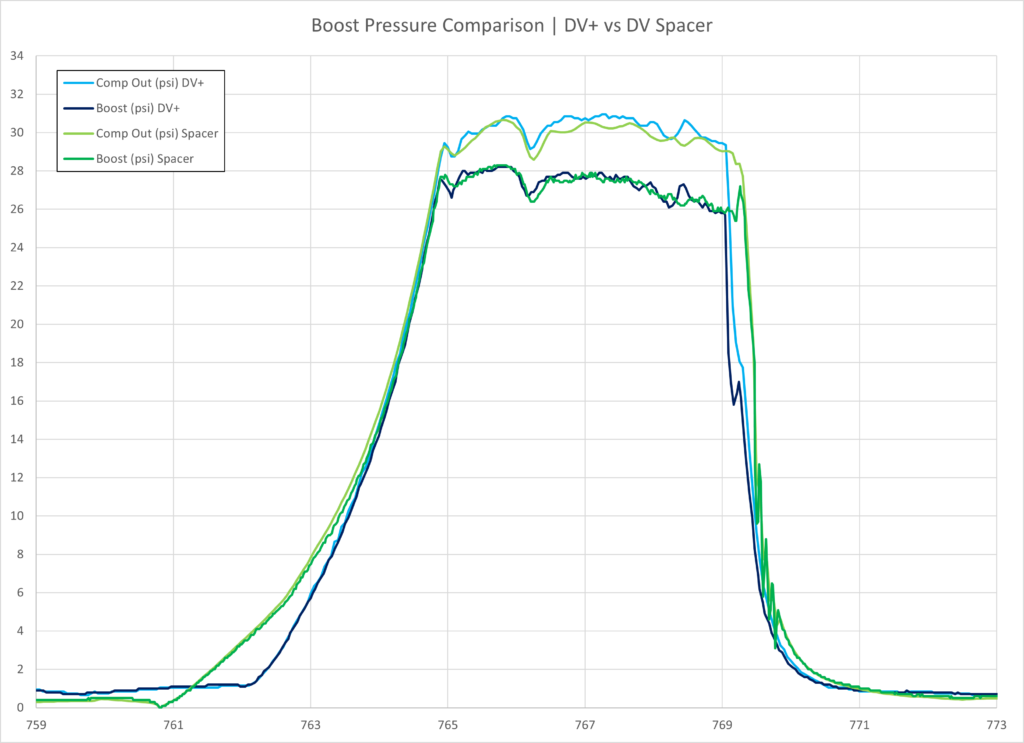
There is no sign of the boost not holding as long with the spacer installed as was reported happening by the person who said you “can legit feel it drop off early“.
Analysis:
While I was having no luck finding an issue with the DV spacer I had a discussion with another owner that gave some clues that provide an alternative explanation for the boost leak reports.
The person explained to me that during routine driving their BOV was venting constantly. (Yes BOV and not DV spacer, stay with me on this.)
I pulled up a log I have of some routine driving to check for the ECU opening the diverter valve. What I found was that the ECU did open the DV occasionally, but was nowhere approaching constantly. This is indicated in the upper half of the chart below by the vertical white lines. These indicate the DV opening and then closing (5x). The lines are vertical because the DV opens or closes in a fraction of a second.

Some additional discussion revealed that the person was noticing this happening during highway cruising. I looked for a log I had of highway driving.
Sure enough, the ECU is opening and closing the diverter valve much more frequently during relatively steady-state highway driving (~70 mph). Shown by the greater number of vertical white lines on the next chart.
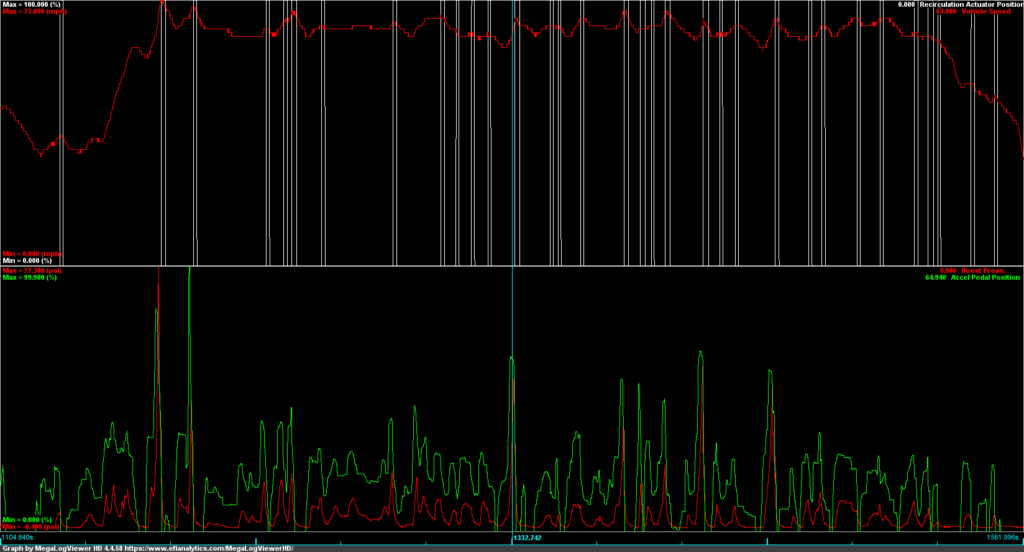
On my GTI I haven’t heard the DV spacer (or BOV) venting during this type of driving, though clearly it is.
Note: I have BFI stage 1 mounts and an aftermarket downpipe and aftermarket exhaust. I believe those combined with tire noise at highway speeds mask the sound of the BOV or DV spacer venting on my car.
What is especially notable about this latest data is that the ECU is opening the diverter valve at what I consider moderate-light pedal input, approximately mid-30% range at 70 mph in 6th gear, shown with the green line on the lower half of the chart above.
There is very little boost being generated under these conditions, typically less than 3 psi, shown by the red line on the lower half of the chart.
While accelerating away from a stop light I encountered a combination of events that had me pulling up the data log shortly after returning home to understand what I had experienced.
While accelerating from a stop moderately rapidly I could hear the DV venting air. Why is air being dumped when the car is being accelerated somewhat rapidly?
The chart below shows some of the significant events that were taking place. (Click on the chart to open a larger version of the image in a new tab)
The data is shown versus time on the x-axis.
During acceleration, once the pedal input exceeds ~30% the throttle plate quickly opens fully, and the wastegate fully closes. (The two leftmost arrows on the lower chart)
Boost pressure starts to build slowly (only 35% accelerator pedal) remaining under 3.5 psi (red arrow – upper chart) and the wastegate begins opening.
The second series of yellow arrows on the lower chart show where right after the gear change (red line – upper chart) from 1st to 2nd (DSG transmission), things get really interesting.
The accelerator pedal (red line – lower chart) is being held steady but the throttle plate closes from fully open to less than 30% (green line – lower chart), the Recirculation Valve (DV) is commanded open (white line – lower chart), and the wastegate opens fully (yellow line – upper chart), and the small amount of boost pressure that has been built up begins to drop off (white line – upper chart).
With the DV open, the venting of air is what I heard.

The throttle then starts opening again, and the wastegate starts closing, but the Recirculation Valve (DV) is left open (white line – lower chart). The DV stays open almost to the point of the next gear change, (furthest right arrow – lower chart).
As the 2nd to 3rd gear shift takes place the same events repeat. The throttle plate quickly closes, the DV is opened, and the wastegate opens fully. More air venting sounds result.
This is all happening while the accelerator pedal is still being held steady at around 35% in 1st and 2nd gear!
What took place there could easily be interpreted as a boost leak. Relatively quick acceleration holding the accelerator pedal steady and having boost pressure being vented out of the DV spacer? Boost leak.
Except that it wasn’t, the car was doing some non-intuitive things.
Conclusion:
Based on appearance there is nothing about the design of the DV spacer that suggests it would be likely to cause boost leaks.
While using a DV spacer I did not measure any adverse effects from the product that have been reported by other Mk7 enthusiasts.
Data logging the ECU management of the diverter valve shows that the ECU opens the diverter valve at some unexpected times.
Given a lack of issues arising in my own data recording, no apparent inherent flaws in the product design, and the absence of data from other GTI owners to substantiate their opinions, I believe it is likely that the behavior of the ECU shown above, opening the DV and venting air at unexpected times, is leading a number of people to mistakenly conclude the DV spacer is causing boost leaks.

The DV venting throughout 2nd gear during light-medium acceleration is quite clearly audible even with my factory DV when the aFe aluminum magnum force pro intake is fitted. The car has never had a dv spacer fitted, is tuned by IE, and exhibits very similar behavior. 19 GTI
Interesting, I mostly use closed intakes so it was a surprise to me to hear it. I’m glad that I was logging the car at the time so I could go back and figure out what had taken place.
Good one! Some of my favorite all-time Bro-Science online comments surround DV spacers/BOVs. I ran a spacer for a few mos…noise maker and of course, no performance issues….how can there be? Removed b/c frankly got sick of hearing it all the time. The DV is just much more active than folks realize and with the stock intake, you don’t hear it. Add a spacer and “bro, it’s leaking..bro”. The running rich/mpg hit comment is amazing!
Yes, I got tired of trying to convince people that the spacer causing an issue is improbable. The myth is well entrenched at this point, it will continue in spite of the only evidence I’ve seen show that it works as designed.
“I stuck with eqt’s recommendation”
Well there’s your problem right there
Honestly. I’ve always found it interesting to see how much bad advice gets tossed around in vw groups. It’s honestly impressive
I love catching shopdap purposely give wrong advice for the sake of making a buck. You can’t even comment they’re wrong on their YouTube videos. Shopdap’s fans jump right down your throat. It’s comical
Cool thing is, when I see folks debunk all the bs. Thanks for the info! Very well written piece! On the fa20, a simple retune allows you to run a vent to atmosphere set up with no issues at all. Maf be damned.
Yes, the amount of misinformation is remarkable. I wish I had a number for the amount of money that gets wasted by people due to following the bad advice.
The strange ECU handling of the DV is the big takeaway here IMO. I’ve noticed the DV venting in regular driving too and it’s good to see some data out to it. I think this is the strange behavior EQT claimed to have fixed in their tunes?
My guess is that it’s functioning as intended, it’s just not what seems normal without understanding why. This was using an EQT tune.